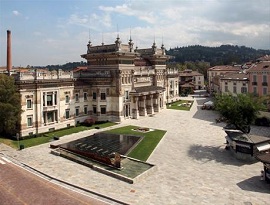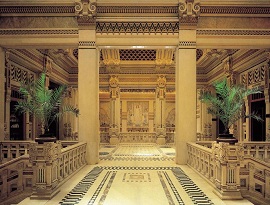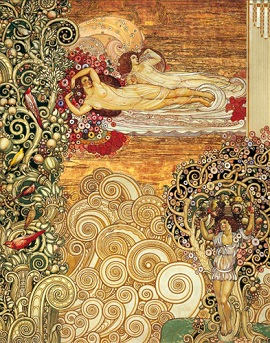

Territory - Liberty path
Lot where once stood the Factory of salt, and later was built the old plant, the baths were begun in 1913 and inaugurated on 27 May 1923.
Immediately hit the originality of the building: a temple of health with all the features of a palace from the East.
The Tuscan architect Ugo Giusti Bernardini was in charge, together with the architect and decorator Galileo Chini, both of Salsomaggiore and the plant "Tamerici" of Montecatini.
In 1917, retired Bernardini, were engaged in the enterprise of building the monumental work Giusti and Chini, who worked together, arriving at the perfect fusion of architecture and decorative which is what is fascinating in this building, made with all ceramic materials and glass products for architecture coming from Fornaci Chini in Borgo San Lorenzo.
The experiences in Far East of Galileo Chini (who decorated the palace of the throne of the King of Siam) emerge evident in his work: Chini plugs into the Tuscan cultural tradition Eastern culture (Chinese, Islamic, Hindu).
Groups of three odalisques, with their elegant and sly poses, ceilings painted with peacock tails, columns, capitals and bases recall the Rajah of India and its mountain temples, while quite strong is the imprint of ancient Assyrian world, with its lions, anthropomorphic figures and bas-reliefs.
The façade of the building is massive, but lightened by an entrance crowned by towers typical of thermal casinos.
The shelter has Roman-style columns, enriched with elements typical of oriental temples, embellished with gold.
The three entrance doors are closed by elegant iron railings, which, like the bars of the windows on either side, were made by the workshop of Antonio Veronesi.
Above the canopy a frieze motifs woven encloses the written THERMAE, supported by two beautiful blue lions.
The building consists of a comb-like structure where three wings rather long and two shorter, ending with two round pavilions, protract perpendicular to the main block, whose façade insists on Piazza Berzieri.
The layout is functional, as the wings are home to all the healing structures, while the reception and foreign office is on the front.
In fact, next to a sumptuous customer reception pavilion opens a less scenic one dedicated to treatments, where is expressed a willingness care in design and decoration, even in the most modest particular.
Designed according to a mathematical rigor, the Berzieri can be crossed in all concatenation.
The double-height atrium, topped by a high frieze with an inscription in Latin, as was the custom in Roman age as well as in Renaissance, is overlooked by two bow-windows, and a second entrance that leads to the wings.
The ceiling is made from a beautiful stained glass window of blue and green.
On the counter-façade the Triptych of Hygeia, painted by Giuseppe Moroni, recalls the function of the building dedicated to the worship of water and woman as goddess of fertility. The setting of the parade and the animals recreate the eastern atmosphere.
Beyond the atrium a large rectangular room serves as a space corridor, from which depart the corridors and the monumental staircase.
The latter, the lodges and the two polygonal spaces overlooking the impressive entrance show a decorative style that might be called "Berzieri", characteristic and unique. Of Arabic influence on the plots are stoneware tiles that cover the entire surface.
The blue lapis lazuli, the magnificent lion heads, deep eaves, windows and ceilings with fish-dragon bring to mind the Thai cities.
Of eastern temples, it preserves like a treasure chest a sense of the sacredness of life and of his renewal: during spring the Dragon comes out of the cave and the cycle of life begins.
The many symbolic references that refer to the dragon seem to invite guests to be attracted from the embracing beauty that the "temple" promises.
Moreover, the whole building is a seashell that contains a secret, it's a magical place that holds the wonderful mystery of life.
 On the walls of the stairwell, Galileo Chini has painted two panels representing female figures immersed in the healing thermal waters between the allegories of Spring and Autumn seasons, the favourite for spa treatments.
On the walls of the stairwell, Galileo Chini has painted two panels representing female figures immersed in the healing thermal waters between the allegories of Spring and Autumn seasons, the favourite for spa treatments.
The painting is very symbolic, recalls at the top of the world of the Viennese Secession by G.Klimt.
The flowering tree and curled decorations are inspired the Florentine Renaissance and the lines of Liberty.
In short, the rich range of colors that animates the Terme corresponds to an equally wide use of materials: glass, ceramic, copper, gold, marble, wrought iron, stucco, chromatic scales which do not affect the clear light of the whole.
The building then presents a synthesis of classic spa tradition, oriental temples and ornamentation Nouveau-Deco.
Spa Centre Berzieri:
The Terme Berzieri, symbol of Salsomaggiore, are fully included among the monuments of national importance to the whiteness of the marble, the sparkle of unique colors, the aristocratic beauty of gilding and decorations in ceramic and glass.Lot where once stood the Factory of salt, and later was built the old plant, the baths were begun in 1913 and inaugurated on 27 May 1923.

Immediately hit the originality of the building: a temple of health with all the features of a palace from the East.
The Tuscan architect Ugo Giusti Bernardini was in charge, together with the architect and decorator Galileo Chini, both of Salsomaggiore and the plant "Tamerici" of Montecatini.
In 1917, retired Bernardini, were engaged in the enterprise of building the monumental work Giusti and Chini, who worked together, arriving at the perfect fusion of architecture and decorative which is what is fascinating in this building, made with all ceramic materials and glass products for architecture coming from Fornaci Chini in Borgo San Lorenzo.
The experiences in Far East of Galileo Chini (who decorated the palace of the throne of the King of Siam) emerge evident in his work: Chini plugs into the Tuscan cultural tradition Eastern culture (Chinese, Islamic, Hindu).
Groups of three odalisques, with their elegant and sly poses, ceilings painted with peacock tails, columns, capitals and bases recall the Rajah of India and its mountain temples, while quite strong is the imprint of ancient Assyrian world, with its lions, anthropomorphic figures and bas-reliefs.
The façade of the building is massive, but lightened by an entrance crowned by towers typical of thermal casinos.
The shelter has Roman-style columns, enriched with elements typical of oriental temples, embellished with gold.
The three entrance doors are closed by elegant iron railings, which, like the bars of the windows on either side, were made by the workshop of Antonio Veronesi.
Above the canopy a frieze motifs woven encloses the written THERMAE, supported by two beautiful blue lions.

The building consists of a comb-like structure where three wings rather long and two shorter, ending with two round pavilions, protract perpendicular to the main block, whose façade insists on Piazza Berzieri.
The layout is functional, as the wings are home to all the healing structures, while the reception and foreign office is on the front.
In fact, next to a sumptuous customer reception pavilion opens a less scenic one dedicated to treatments, where is expressed a willingness care in design and decoration, even in the most modest particular.
Designed according to a mathematical rigor, the Berzieri can be crossed in all concatenation.
The double-height atrium, topped by a high frieze with an inscription in Latin, as was the custom in Roman age as well as in Renaissance, is overlooked by two bow-windows, and a second entrance that leads to the wings.
The ceiling is made from a beautiful stained glass window of blue and green.
On the counter-façade the Triptych of Hygeia, painted by Giuseppe Moroni, recalls the function of the building dedicated to the worship of water and woman as goddess of fertility. The setting of the parade and the animals recreate the eastern atmosphere.
Beyond the atrium a large rectangular room serves as a space corridor, from which depart the corridors and the monumental staircase.
The latter, the lodges and the two polygonal spaces overlooking the impressive entrance show a decorative style that might be called "Berzieri", characteristic and unique. Of Arabic influence on the plots are stoneware tiles that cover the entire surface.
The blue lapis lazuli, the magnificent lion heads, deep eaves, windows and ceilings with fish-dragon bring to mind the Thai cities.
Of eastern temples, it preserves like a treasure chest a sense of the sacredness of life and of his renewal: during spring the Dragon comes out of the cave and the cycle of life begins.
The many symbolic references that refer to the dragon seem to invite guests to be attracted from the embracing beauty that the "temple" promises.
Moreover, the whole building is a seashell that contains a secret, it's a magical place that holds the wonderful mystery of life.
 On the walls of the stairwell, Galileo Chini has painted two panels representing female figures immersed in the healing thermal waters between the allegories of Spring and Autumn seasons, the favourite for spa treatments.
On the walls of the stairwell, Galileo Chini has painted two panels representing female figures immersed in the healing thermal waters between the allegories of Spring and Autumn seasons, the favourite for spa treatments.The painting is very symbolic, recalls at the top of the world of the Viennese Secession by G.Klimt.
The flowering tree and curled decorations are inspired the Florentine Renaissance and the lines of Liberty.
In short, the rich range of colors that animates the Terme corresponds to an equally wide use of materials: glass, ceramic, copper, gold, marble, wrought iron, stucco, chromatic scales which do not affect the clear light of the whole.
The building then presents a synthesis of classic spa tradition, oriental temples and ornamentation Nouveau-Deco.
